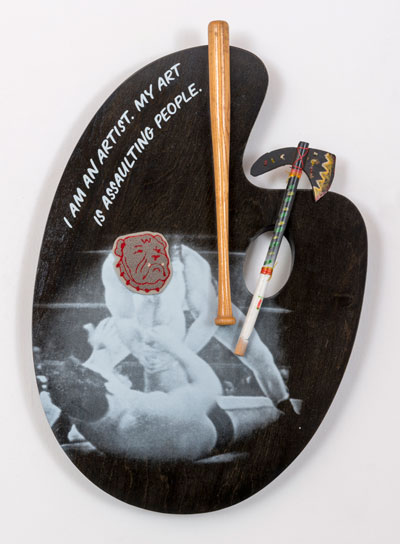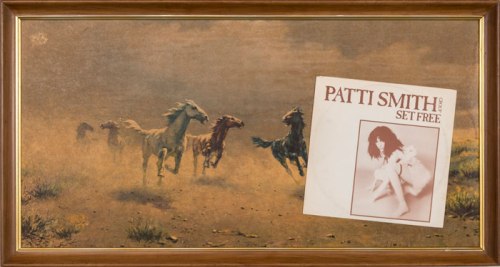“Alexis Smith at Honor Fraser” ARTPULSE Magazine. Vol. 4 No. 16. Summer 2013.
Slice of Life’s highlight is undoubtedly Past Lives, a work originating in 1989 as a collaboration with the writer Amy Gerstler. The installation takes up an entire room, filling it with a diverse collection of weathered children’s chairs, from a classic wooden rocker to a Lilliputian canvas director’s chair. As one circumnavigates the empty seats, a palpable sense of absence takes hold. Nearby, a schoolroom chalkboard bears sentences befitting an obituary headline, like, “Came to literature late.” The entire installation conjures thoughts of how indoctrination marks one from early childhood, how ideology, circumstance, and the language of control determines the roles we play in life.

Alexis Smith, Black and Blue for Howie Long, 1997. Mixed media collage, 29 x 19 x 4 in.
Courtesy Honor Fraser Gallery, Photo Joshua White: JWPictures.com
Many of Smith’s works use humor as a foil to discuss issues of violence, manipulation, and American culture. This is no better seen than in a 1997 mixed media collage, “Black and Blue for Howie Long.” In this work we read the NFL player and bit actor Howie Long’s pithy quote, “ I am an artist. My art is assaulting people” written in comic sans on a large painter’s palette alongside a photograph of two men wrestling, with one head replaced by a Georgia Bulldog’s face. Continuing the sports tableau, a baseball bat and children’s toy tomahawk sit atop the palette like menacing paintbrushes. The work’s tautological wordplay ricochets around the gallery, branding the “artist” as a contextual and perhaps menacing position. Such a proposition deserves a chuckle. Yet the play of meaning doesn’t stop there. The baseball bat and tomahawk continue the chain of signification, pointing to both America’s pastime: baseball, and America’s past time: Native American history and identity and a culture relegated to sports mascots and comic caricatures. At least that’s how I see it.
There are equally engaging recent works in the show, like “Wild Horses,” a 2012 collage of the cover of the Patti Smith Group EP “Set Free” placed above a thrift store painting of unbridled horses in a desert landscape. Such a simple construction performs impressive and lasting tricks, riffing on questions of high and low, artistic titling, and the importance of name recognition. Its word and image play is so perverse I wish it were a billboard on Sunset Blvd.

Alexis Smith, Wild Horses, 2012. Mixed media collage, 22 x 24 in.
Courtesy Honor Fraser Gallery, Photo Joshua White: JWPictures.com
Like Rauschenberg before her, Alexis Smith’s work, at its best, plays expertly on the precipice of communication. In her most successful works signifiers flirt with intelligibility while refusing didacticism. Smith’s constructs her signifiers with considered arrangement, with just enough connections to create an ouroboros of signs, with one image’s meaning devouring another, with no final cathartic “resolution.” The images turn back on themselves allowing for a slow-burn critique that always finds itself home in the present.
©2024 Tucker Neel. All rights reserved.